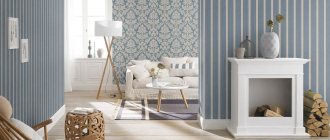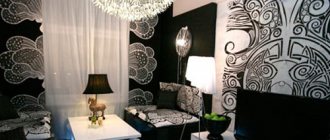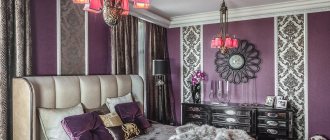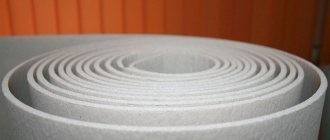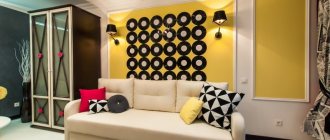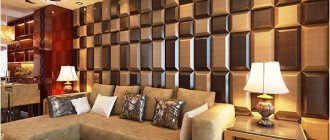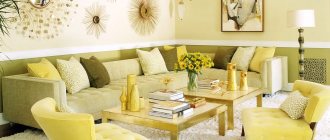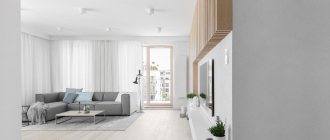Pros and cons of decorating walls with wallpaper
Wallpaper is the most common method of finishing walls in residential premises. Construction stores offer an incredible variety of colors, textures and materials, which allows you to choose the ideal option taking into account the characteristics of the apartment.
| pros | Minuses |
| Firstly, the advantages include a wide selection of colors and various effects. Today you can make a selection to suit any style, with imitation of various materials and absolutely any image, from a nondescript ornament to a complex artistic 3D image. | Despite all the positive qualities, wallpaper for walls still cannot boast of such durability as, for example, ceramic tiles. Only a few species can withstand animal claws and other household damage. |
| Variety in price can also be considered an advantage. The cost of wall coverings depends on the characteristics and type of material and some of them are quite expensive, but the price range starts with very budget models. | Walls of shower areas and open balconies cannot be finished. |
| Not all types have a long lifespan, although some reach 30 years. | |
| The variety of types allows finishing in rooms with different conditions, for example, high humidity, abundant lighting or possible frequent mechanical damage. | Some types are almost impossible to wash from various types of contaminants. |
Interior decoration with molding: features of the work
When decorating an interior, there are a number of features and nuances that you need to become familiar with. This will eliminate a number of mistakes, make the appearance of the room unique, and extend its service life.
How to paste under wallpaper
Basically, the color of the molding is chosen not only so that it matches the wallpaper, but also emphasizes the design of the room.
If the wallpaper is light in color, the room is large and spacious, then light-colored planks are used.
However, when introducing dark tones into the design, for example furniture, they create a contrast - highlighting the light wallpaper with a dark finish.
When and how to glue wallpaper
Wallpaper is glued when all finishing work is completed. That is, a day after gluing the plank, it is painted in the desired tone. After drying, grout is done, removing all excess. Only after this the wallpaper is glued. They must be glued carefully butt-to-metal with the molding. You need to make sure that the edge of the canvas is smooth and does not overlap the bar. Otherwise, the appearance will be spoiled.
How to properly glue frames made of different materials
Almost all planks are glued to the base, with the exception of wood. It is secured with self-tapping screws. After the markings are made and the planks are cut according to size, the corner parts are glued first. You need to make sure that the angle is even. Afterwards, horizontal and vertical strips are attached to the corner elements.
For strength, holes are made in the planks for self-tapping screws. After drying, the screws are removed and the holes are sealed with putty.
How to attach metal and wooden baguettes for decoration
Metal and wood slats are heavy. They are not mounted with glue. To decorate a wall or doorway, the planks are fixed with self-tapping screws and dowels. The pitch between the screws is determined based on the size of the strip, as well as its width and weight.
How to glue polyurethane baseboard frames under wallpaper
Polyurethane strips are glued to the base using:
- White liquid nails.
- Glue for polyurethane, for example "Oras".
- Polymer universal glue “Dragon”.
All adhesives have good adhesion and a number of features.
In what cases is the baguette not attached to the wallpaper?
Craftsmen do not recommend attaching molding to wallpaper. However, if the wallpaper has been hung recently, it is good to stick to the surface, then the strips are attached to the canvas. But there is no guarantee that the decor will remain in place for a long time. Under its weight, it can peel off and tear the wallpaper.
Types of wallpaper
Each type of wallpaper for walls has its own distinctive features, different characteristics, composition and external effects. If there are some doubts about the choice of material, then there is a detailed overview of all types, thanks to which you can choose the most optimal option, taking into account all the nuances of the room.
- Paper. Budget type of wall decoration with a large selection of colors and patterns. The material has poor strength and durability, fades in the sun, absorbs odors and is practically not suitable for any cleaning. Paper ones are suitable for finishing enclosed spaces with the least possible contact, for example a bedroom or the upper part of a nursery, a corridor with a horizontal finishing method.
- Non-woven. This species can be divided into two subspecies. Fully non-woven wallpaper with a non-woven base. The first type is most often used for painting. It has a varied relief texture that can match almost any stylistic direction. The second type has a top layer of vinyl, they do not need to be painted, the surface can have a different pattern and color.
- Vinyl. This popular type of wallpaper for walls is durable and strong. Vinyl coating is made in different variations with different external effects: silk-screen printing, foamed, hard vinyl. The surface is suitable for wet cleaning and finishing of any premises.
- Liquid. This type is different from all the others. They are purchased in powder form and diluted in water before use. Liquid wallpaper is applied to walls like plaster, which avoids joints on the surface. The material breathes and goes well with other methods of wall decoration.
- Glass wallpaper. The most durable type of all listed. The composition uses glass, which under the influence of high temperature is drawn into fibers, and then turns into canvas. Fiberglass wallpaper for walls is most often used for painting. The coating has a breathable surface, is suitable for repeated painting, and is not afraid of mechanical damage and high humidity.
- Textile. The material has a base and an upper textile covering, which can be made of different materials. The wallpaper has excellent appearance and natural composition, protects against noise and does not react to sunlight. However, dust can settle on the surface, with the exception of linen coverings and the material absorbs odors.
- Linkrusta. Wall coverings of this type are not so widely popular, but their quality characteristics are superior to other materials. The composition of linkrust is absolutely natural, based on wood. The coating is not afraid of mechanical damage and high temperature, has a long service life and an elegant appearance.
- Natural. This type includes bamboo and cork coverings, which are made from natural raw materials. The materials, first of all, are environmentally friendly, resistant to changes in humidity and temperature, and are suitable for finishing balconies and verandas. Natural wallpaper for walls does not differ in the variety of colors and textures.
- Photo wallpaper. Wallpaper with photo printing will make the interior unusual, stylish and individual, and will also successfully cope with the issue of space zoning. The drawing can be close to the real image (cities, flowers, animals), with a 3D effect, stereoscopic or expand the space.
The photo shows a modern bedroom interior, the walls are decorated with wallpaper with a three-dimensional pattern.
How to make a wallpaper border with your own hands
Strips for separating wallpaper are used in the following cases:
- Distinction between fabrics made from the same material, but with a different pattern or color.
- In large rooms, as well as studio apartments, wallpaper is used to delineate the boundaries between the kitchen and the bedroom.
Zoning space is one of the important functions of wallpaper edging.
Materials for making decorative baguettes
Basically, the decoration is glued to the wall. In rare cases, self-tapping screws are needed.
The choice of adhesive mixture depends on the material from which the plank is made and the room in which the installation will be carried out.
- For light planks, PVA glue or wallpaper glue is suitable.
- Gypsum strips are attached to a gypsum solution.
- Wood planks do not last long on glue.
Some types of adhesive for installation:
- Loctite PL 355 – moisture-resistant adhesive, made in Germany. Glues light baseboards and moldings.
- Decomaster 250 – moisture resistant. Designed for gluing ceiling plinths and moldings.
- Stayer Professional is a moisture-resistant adhesive mass produced in Germany. The finishing material is glued at above-zero temperatures.
All types of glue are used for light finishing materials.
Work progress
Preparatory process. The walls must be smooth. If there are strong differences, the finish will come off over time and a gap will be visible.
- clean the walls from dust, cover with primer;
- make markings using a level or plumb line (vertically);
- if the slats are wide, you need to use self-tapping screws. To do this, holes are made in the molding.
You can paint the finish only a day after the glue has dried.
Fastening methods:
- Sticking the finish to a bare, cleaned wall means it will have a long service life. Even when replacing wallpaper, the strips will remain in place. In some cases, it is difficult to match the wallpaper to the pattern.
- Sticking strips to wallpaper has negative sides. It is short-lived, but there is no need to adjust the wallpaper.
Tools needed for installation:
- hacksaw for cutting planks;
- miter box for cutting trim at a certain angle;
- construction glue gun;
- spatula (in some cases);
- excess sandpaper for grouting.
Molding installation
Before starting work, you need to measure the required length of the planks and cut them. Use a miter box to cut off the corners. After this, the elements are glued in the corners according to the markings. After this, even planks are attached according to the markings. If there are gaps left after gluing, they must be covered with the same glue. All work is left for 24 hours to dry completely.
Wallpaper finishing
After the glue has dried, the planks are painted in the desired color. Use sandpaper to remove excess glue along the edges.
After the work has been done, the wallpaper is finished. To do this, you need to measure the height and width of the canvas and carefully glue it end-to-end with the strip. It is necessary to ensure that the edge of the wallpaper is perfectly smooth and fits evenly with the finish. The canvas is not allowed to overlap the molding. It is then difficult to cut it off; uneven edges and traces of wallpaper glue will remain.
If the finishing is carried out close to the corner, you need to carefully bring the edge of the wallpaper to the molding, and then bring it to the corner.
Color spectrum
Table of the most popular colors
Beige
Turquoise
Blue
Gold
Reds
Lilac
Purple
Burgundy
Yellow
Greens
Brown
Orange
Peach
Light green
Gray
Blue
Black
White
Pink
Mother of pearl
The iridescent surface will look interesting in the light, and if a relief pattern is applied, it will create a play of light and the illusion of volume. Mother-of-pearl wallpaper for walls can be in the form of an imitation of Venetian plaster or silk-screen printing. Both options suit different styles and look impressive.
The photo shows mother-of-pearl walls in blue tones.
Mints
A refreshing shade is suitable for decorating rooms with south-facing windows. The color is like a fusion of light turquoise and blue shades, it will look good in modern, Scandinavian, Provence, shabby chic styles.
Using wallpaper in different interior styles
Wallpaper can be used in any style. But there are interiors where they look more organic. Among these:
- Classical. Suitable for images of arches, marble or columns. The canvas should reflect luxury, elegance, pomp and wealth. Imitation of a velvet surface, intricate patterns and monograms. The gamma is predominantly pastel, calm;
The canvas should reflect luxury, elegance, pomp and wealth. - Provence. Creates an atmosphere of a French village within the walls of the room. Canvases are chosen with images of fields with lavender, flowers, sunflowers. But patterns and designs should not be flashy. The palette is calm and sophisticated;
Creates an atmosphere of a French village within the walls of the room. - Loft. Canvases depicting the texture of wood, brick, metal, and urban landscapes are suitable. 3D wallpaper will fit;
Canvases depicting the texture of wood, brick, metal, and urban landscapes are suitable. - Baroque. Mustard, yellow and caramel tones predominate. Wallpaper should imitate material materials.
Mustard, yellow and caramel tones predominate.
How to choose the right wallpaper?
Simple rules and some tricks will help you choose the best option for finishing.
- For a small room, you should choose a light palette for decoration.
- Wallpaper with stripes, depending on the direction, will visually make the room taller or wider.
- To visually bring the wall closer or reduce the space, wallpaper in bright colors and with large patterns is suitable.
- For rooms with high traffic or a high probability of mechanical contacts, it is better to choose anti-vandal coatings.
- Washable coatings with high moisture resistance are suitable for the kitchen, bath and toilet: vinyl, fiberglass, liquid, self-adhesive.
- For a child’s room, you should choose the safest possible material; eco-friendly wallpaper, such as cork, glass wallpaper, or bamboo, is suitable.
- For a country house or cottage, you need to choose a material that is not afraid of temperature changes and humidity.
- The color palette should reflect the character of the owner; to decorate a women’s room, you can choose delicate pastel and light shades. Brutal cold shades are suitable for a masculine interior.
- For those who are interested in Feng Shui, it is worth paying attention to colors, each shade has its own meaning, for example, white clears the mind, blue inspires, and green has a calming effect.
For the hall
Homeowners often do not spend as much time in the living room as in other rooms. That is why gluing vinyl wallpaper is appropriate here, which is not recommended for decorating bedrooms, children's rooms and work rooms.
Most often, the room is well lit by sunlight, so the selection of smooth textures in unobtrusive cool shades will harmoniously emphasize a large, bright room.
Photo wallpapers pasted on only one wall also look elegant.
Additionally, you can play with the textured surface using spotlights. They will not only serve as an additional source of lighting, but also highlight the unusual surface topography.
The living room looks even more solemn if you choose silk textile finishing materials. They will give the room a special gloss and appropriate pomp and will be interestingly combined with curtains.
Rules for decorating walls with wallpaper
When working with wallpaper, you must follow simple, but still rules.
- It is necessary to apply wallpaper only to the prepared surface; the walls must be cleaned, leveled and primed,
- The glue must be selected in accordance with the characteristics of the material; for some types, glue for heavy types of coatings will be needed.
- When choosing wallpaper for walls, you need to take into account the features of caring for them. To do this, a marking is placed on the back of the roll or package indicating the degree of interaction with moisture.
- Structural wallpaper for walls designed for this purpose, such as fiberglass or non-woven, is suitable for painting.
- It is important to pay attention to the symbols on the packaging; they greatly simplify the choice.
- When combining wallpaper for walls, you need to select canvases of equal thickness and preferably from the same manufacturer.
- Regular maintenance can extend the life of the coating and maintain its appearance.
How to calculate the amount of wallpaper by wall area
There are different methods for calculating the required amount of materials. In addition to special calculators and calculations based on the area of the room, you can find out the necessary information based on the area of the walls. The method is accurate and economical, especially if you have a large space to cover. The calculation of wallpaper per room based on wall area is as follows:
- Measure the area of the room. The resulting figures are multiplied by the height of the ceiling;
- Determine the area of doors and window openings;
- The previous value is subtracted from the total area of the walls. Obtain the total area requiring pasting;
- Multiply the width of the roll by the length and get the area of the canvas in one roll;
- The area of the walls is divided by the value obtained in the previous step.
The resulting numbers should be rounded up. This will be the number of rolls required for wall cladding.
In addition to special calculators and calculations based on the area of the room, you can find out the necessary information based on the area of the walls.
Clinker tiles
The use of this material will help achieve the desired design solution. This material is not inferior to natural options.
This material is not difficult to work with, it lasts a long time and is moisture resistant.
Look also here:
Electrical panel in a private house- 3 types of floor slabs
What determines the cost of a plastic window?
Resists damage. The tiles have a large selection of colors that will be preserved and will not fade in the sun. Mold and other fungi do not appear on this tile. Lasts a long time and resists fire.
Original cork backing for the wall instead of wallpaper
Very often, cork is used as a finishing material, mounted on the wall, which is one of the most popular and quite in demand finishing materials. Cork backing is a fairly beautiful and versatile material that can be used to easily decorate the surface of walls.
The use of such materials is different in that it is possible to properly level the walls before using the main finishing material.
Such wall panels are characterized by unusually high performance characteristics, can withstand heavy loads, and are also very environmentally friendly. Thanks to such indicators, it is quite possible to use wall panels in absolutely any room, regardless of its purpose, because they are completely safe for health. A wide variety of colors and textures allow you to use wall panels to decorate each room and make it unique and unique.
Self-adhesive wallpaper is a universal material for both wall decoration and furniture decor. Read how to work with it in our material: https://homeli.ru/remont-i-otdelka/steny/oboi/samokleyashchiesya-oboi
Fabric on the walls instead of wallpaper: modern materials
Instead of wallpaper on the walls, you can use natural fabric, covering the entire walls with it. The advantage of this method of pasting is that you can decorate walls, windows and use fabrics for sewing curtains in the same style. To create a unique kitchen interior made in country style, you should use a floral fabric, pasting it over the kitchen apron and additionally covering it with several layers of varnish to make it waterproof. From the same fabric it is quite possible to sew beautiful curtains, tablecloths, chair covers and napkins. This design turns out to be very stylish and original.
Decorating walls with natural fabric requires special skill and dexterity, so it is advisable to use the services of professionals.
To decorate walls with fabric, you must first carefully prepare the walls, because all the imperfections on the walls immediately become noticeable. Pasting walls with natural fabric is used to decorate not the entire room, but only part of it. Often this material is combined with wooden wall panels. A wall decorated with fabric becomes central to the entire room and attracts the main attention.
